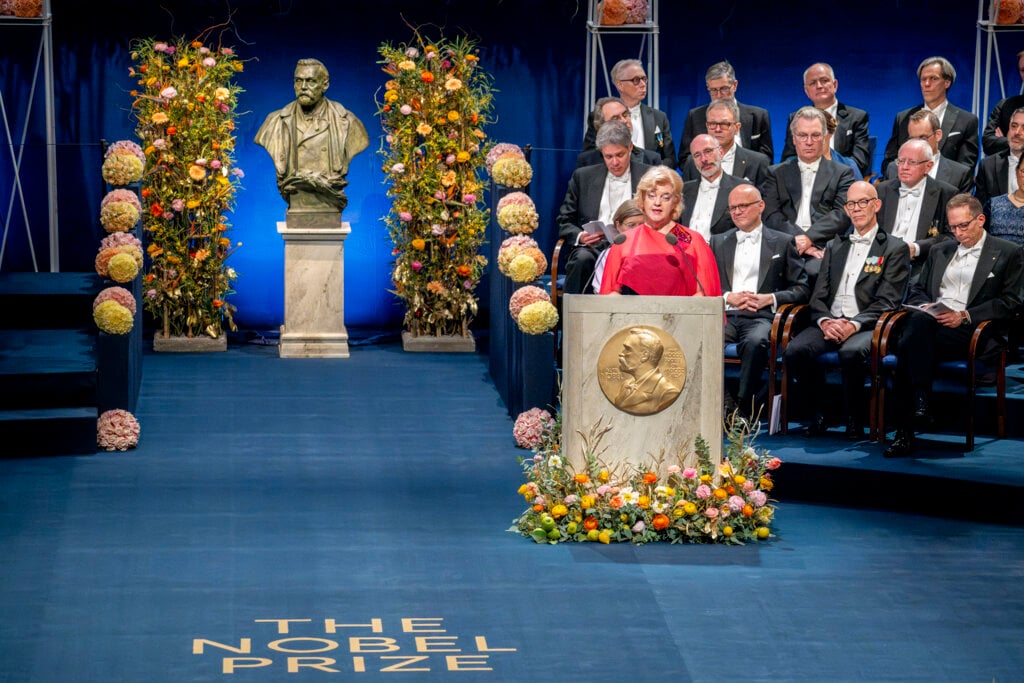Award ceremony speech
English
Swedish

English
Swedish
Presentation Speech by Professor Eva Olsson, Member of the Royal Swedish Academy of Sciences; Chair of the Nobel Committee for Physics, 10 December 2023.
Your Majesties, Your Royal Highnesses, Esteemed Nobel Prize Laureates, Ladies and Gentlemen,
“The world is so big so big …
Bigger than you ever can imagine …”
These are words by Zacharias Topelius, and they illustrate the fact that we are part of a vast system. A system that we are exploring.
However, the big is controlled by the smallest details that are beyond the capabilities of our five traditional senses of sight, smell, touch, taste and hearing. These small details have a great impact on our lives and offer intriguing possibilities for expanding our knowledge.
They give us the power to design materials and methods for exploration, for future sustainability and for promoting health. This applies to both length and time scales. This year’s Nobel Prize in Physics is focused on small time scales, and to be precise, on attoseconds.
A heartbeat lasts for one thousand thousand thousand thousand thousand thousand attoseconds. This is the same number of seconds since the universe came into existence. The attosecond is the time scale of the world of electrons – a world that we now can explore. Back in 1925, Werner Heisenberg argued that this world cannot be seen, but, thanks to attosecond light pulses, this is starting to change. The challenge was the extremely short time scale. It took several decades to overcome this barrier. Attosecond science allows us to address fundamental questions, such as the time scale of the photoelectric effect – for which Albert Einstein received the Nobel Prize in Physics in 1921.
With attosecond pulses, we can study how the distribution of electrons oscillates within molecules and materials. This information about charge fluctuations holds secrets and solutions to how to control electronic migration. With attosecond chemistry, specific chemical bonds can be selectively broken or formed, giving us control in making new compounds. With attosecond physics, we can study charge-transfer processes in materials. They are the key elements in the function and optimisation of solar cells, batteries, catalysts and electronics.
The origin of this year’s prize can be traced to the late 1970s and early 1980s when atoms in strong laser fields were studied. Our laureates discovered that it was possible to generate attosecond pulses by controlling the interaction between lasers and atoms. They developed methods for measuring the duration of light pulses. They also developed techniques for generating both pulse trains and isolated individual pulses.
Emeritus Professor Agostini, Professor Dr Krausz and Professor L’Huillier,
You have been awarded the 2023 Nobel Prize in Physics “for experimental methods that generate attosecond pulses of light for the study of electron dynamics in matter”. It is an honour and a privilege to convey to you, on behalf of the Royal Swedish Academy of Sciences, our warmest congratulations. I now ask you to step forward to receive the Nobel Prize from the hands of His Majesty the King.
Copyright © The Nobel Foundation 2023
Nobel Prizes and laureates
Six prizes were awarded for achievements that have conferred the greatest benefit to humankind. The 12 laureates' work and discoveries range from proteins' structures and machine learning to fighting for a world free of nuclear weapons.
See them all presented here.
